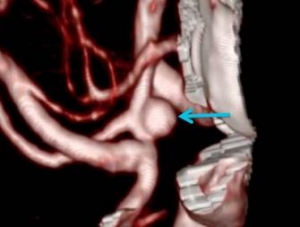Cerebral (Brain) Aneurysm
Overview and Facts about Cerebral (Brain) Aneurysm
 A cerebral aneurysm is a weak spot on an artery (blood vessel that carries blood from the heart to the rest of the body) in the brain that balloons out in a pouch-like sac and fills with blood.
A cerebral aneurysm is a weak spot on an artery (blood vessel that carries blood from the heart to the rest of the body) in the brain that balloons out in a pouch-like sac and fills with blood.
If this sac grows large enough, it can put pressure on a nerve or the brain tissue around it and may rupture. Fortunately, the risk of a rupture is very low (on average less than one percent a year) for most aneurysms.
About three percent of adults will have a cerebral aneurysm, also commonly called a brain aneurysm.
Most aneurysms are small and cause no symptoms. They are often found during an MRI or CT scan done for other reasons.
Why Choose Loyola for Treatment of Cerebral (Brain) Aneurysm?
The neurosurgical team at Loyola has expertise in diagnosing, monitoring and treating the most complex cases of cerebral aneurysm, ensuring you get the best, personalized care.
Our neurovascular surgeons, interventional specialists, radiologists, technicians, nursing staff and social workers are all highly experienced and experts in their fields.
Causes and Risk Factors of Cerebral (Brain) Aneurysm
The chance of developing a cerebral aneurysm depends on a number of genetic and lifestyle risk factors that can stress or weaken artery walls, including:
- Age: Cerebral aneurysms are more common in adults than children.
- Drug abuse (use of stimulating drugs such as cocaine or methamphetamines).
- Family history of cerebral aneurysms: If two first-degree relatives in your family have a history of cerebral aneurysm, you should have imaging tests (such as MRI or CT scan) performed to assess your risk.
- Female gender: Women are 50% more likely to develop a cerebral aneurysm than men.
- Genetic conditions that weaken the arterial wall, such as polycystic kidney disease, Ehlers-Danlos syndrome, Marfan’s syndrome and fibromuscular dysplasia.
- Growth of a known aneurysm
- Heavy alcohol use (more than seven drinks a week)
- High or poorly controlled blood pressure
- Personal history of a previously ruptured aneurysm
- Smoking: 75% of patients with a ruptured aneurysm are cigarette smokers.
If you or your primary care doctor suspects you are at risk of a cerebral aneurysm, you can arrange to have imaging tests performed, such as an MRI or CT scan.
Symptoms and Signs of Cerebral (Brain) Aneurysm
Most aneurysms are small and cause no symptoms. They are often found during an MRI or CT scan done for some other purpose.
However, they can become symptomatic by growing large enough that they place pressure on neural structures or if they rupture.
Signs of an Unruptured Aneurysm
- Eye issues, including pain above and behind the eye, drooping eyelid, blurred/double vision or dilated pupil
- Weakness, numbness or paralysis on one side of the face
Signs of a Ruptured Aneurysm
- A “thunderclap” headache – the worst headache the patient has ever experienced
- Blurred/double vision
- Loss of consciousness
- Light sensitivity
- Nausea and vomiting
- Seizure
A ruptured aneurysm is a medical emergency requiring immediate attention and transportation to an emergency room for neurosurgical evaluation.
Tests and Diagnosis of Cerebral (Brain) Aneurysm
If you have the symptoms of a cerebral aneurysm, especially a sudden, severe headache, your doctor may recommend several tests to determine the cause:
- Cerebral angiogram
- Cerebrospinal fluid test
- CT scan
- MRI (magnetic resonance imaging)
These tests will help reveal the condition of your arteries around the site of the possible aneurysm. Your doctor may also recommend one or more of these tests if two first-degree relatives in your family have a history of cerebral aneurysm.
Treatment and Care for Cerebral (Brain) Aneurysm
Most aneurysms do not need treatment, but – once discovered – are screened periodically (active surveillance) to make sure they are not growing.
The decision to treat or not treat an aneurysm is based on calculating the risk that an aneurysm may rupture during a patient’s lifetime. Factors used to determine the risk of rupture include:
- Location: An aneurysm in the back of the brain is at higher risk for rupturing than an aneurysm at the front of the brain
- The size and shape of the aneurysm
- If the patient has a history of a previous aneurysm rupture
- The patient’s age and overall health
Surgical Treatments for Cerebral Aneurysms
The goal of treating an aneurysm is to seal it off, preventing it from filling with blood so it cannot rupture.
Two different surgical approaches are effective in treating cerebral aneurysms: microsurgical clipping and endovascular coiling.
Both are excellent treatment options for cerebral aneurysms, and your neurovascular specialist will help make the right choice for you.
Prevention of Cerebral (Brain) Aneurysm
While some of the risk factors of a cerebral aneurysm cannot be changed (age, gender, family history), there are several lifestyle changes you can make to reduce the chance of developing an aneurysm.
- Control blood pressure by eating a healthy diet, cutting down on alcohol and caffeine, maintaining a healthy weight and exercising regularly
- Quit smoking

